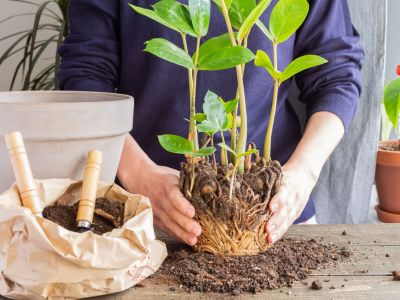How to Repot a Houseplant
When it’s time to repot your plant, you should use a combination of plastic pots and peat-based compost. Of course, this depends on the plant’s requirements. First, soak the clay pot for a day before using it so the pot won’t draw the water out of the compost. Pots are available in all sorts of sizes but you usually only need four or five different sizes. The most common sizes used are the 6 cm., 8 cm., 13 cm., 18 cm., and 25 cm. You will always want to leave enough space between the rim of the pot and the surface of the compost; as that’s your watering space. It should increase with the size of your pot because larger pots hold larger plants, which require more water. When one of your houseplants is in a large pot and can’t be repotted, you’ll have to top-dress the compost. What this means is you will have to remove the top 1 to 1 1/2 inches (2.5-4 cm.) of old compost and replace it with fresh compost. Be sure not to damage the plant’s roots and leave a gap between the top of the compost and the rim of the pot so that the plant can be watered easily.
Steps for Repotting Houseplants
Repotting a houseplant is easy when following these basic guidelines for houseplant repotting:
First, water the plant the day before you plan on repotting it. Put your fingers over the top of the root ball and invert the pot. Tap the pot’s rim on a firm surface, like a table or counter. If the root ball resists, run a knife between the pot and the root ball to loosen the roots. Inspect the roots and remove the crock from the root ball’s base when repotting a houseplant into a clay pot. Tease the roots free. You might have to use a stiff label or sticker. After that, pick a clean pot a little larger than the one from which you just removed the plant–normally going up a couple pot sizes. Place a nice, firm handful of fresh compost into the pot’s base. Place the root ball on top of that in the center. Make sure the surface of that root ball is below the rim so you can cover it adequately with compost. Once you have the plant in the correct position, gently place some fresh compost around it and over it. Do not ram the compost into the pot tightly. You want to give the roots some ability to move and grow. Finally, if you think it’s necessary, add more compost on top and gently make it firm. Be sure to leave the recommended amount of space on top for watering purposes. Put the plant where moisture can drain freely and trickle water onto the plant filling the watering space on top. Allow extra water to drain out and place the pot in an attractive outer container to catch any excess. You won’t want to water this plant again until the compost shows some signs of drying out.
Now that you know how to repot houseplants, you can enjoy them even longer year-round.
